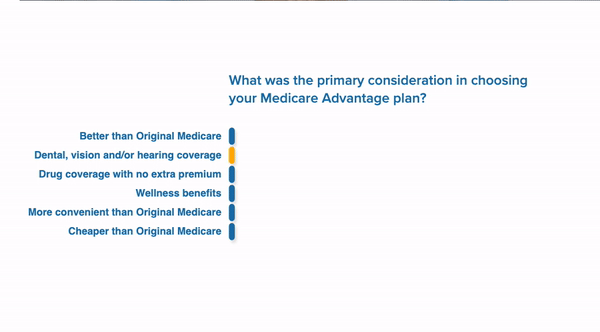What You Need to Know
A Medicare Advantage (MA) plan is a bundled alternative to Original Medicare.
You can only enroll in an MA plan at certain times of the year and in specific circumstances.
The average cost for an MA plan in Wisconsin is $33.65 per month. This is higher than the national average of $21.
What Are Medicare Advantage Plans in Wisconsin?
Out-of-pocket expenses are one of the most frustrating aspects of healthcare. Even Medicare has deductibles, copayments, and coinsurance. Medicare Advantage plans (also known as Medicare Part C) can help Wisconsin residents with those costs.
A Medicare Advantage (MA) plan is an alternative to Original Medicare. It bundles together your Medicare Part A and Part B benefits. MA plans typically also include Medicare Part D (prescription drug) benefits as well as other benefits not covered by Medicare, such as dental, vision, and hearing care.1
What Types of Medicare Advantage Plans Are Available?
You can choose among several types of MA plans. One of the important differences among plans is whether you’re required to use a provider network. A provider network is a group of healthcare providers that have contracted with the insurance plan. Here are the types of MA plans:
- Health maintenance organization (HMO): HMOs require that you receive care from providers who belong to their network unless it’s an emergency or you’re traveling and need urgent care or dialysis. You typically need a referral to see a specialist.
- Preferred provider organization (PPO): This plan type allows you to visit providers who aren’t part of a provider network, but you typically pay more if you do. You usually don’t need a referral to see a specialist.
- Private fee-for-service (PFFS) plans: This option allows you to go to any provider who accepts the plan’s terms and conditions. Some of these plans have a network, and if they do, you pay more if you receive care from an out-of-network provider.
- Special needs plans (SNPs): These plans are designed to service Medicare members with specific healthcare needs. There are three types:
- Chronic condition SNP (C-SNP): This plan is for Medicare beneficiaries with certain health conditions, including autoimmune disorders, dementia, diabetes, end-stage renal disease (ESRD) and chronic lung disorders.
- Institutional SNP (I-SNP): This plan type is for those who live in an institution, such as a nursing home, or who need nursing care at home.
- Dual eligible SNP (D-SNP): This option is designed for those who are eligible for both Medicare and Medicaid.
- Medical savings account (MSA) plans: MSA plans combine a high-deductible MA plan with a medical savings account (MSA). The plan contributes to the MSA, and you can use the funds to pay for Medicare-covered healthcare services. If you use all the funds in your MSA, you must cover your out-of-pocket healthcare expenses until you meet your plan’s deductible. After that, your plan will cover your Medicare-approved healthcare.2
Look for Medicare Cost Plans
Some Medicare-approved HMOs in certain areas of Wisconsin offer these plans, but you must receive care from in-network providers to receive plan benefits.
What Are Prescription Drug Options with Medicare Advantage Plans?
Eighty-nine percent of all MA plans include Medicare Part D prescription drug coverage.3 If you buy an HMO or PPO plan that doesn’t include prescription coverage, you cannot buy a separate Part D plan. If you buy an MSA plan or certain PFFS plans, you can buy a separate Part D plan.
If you don’t enroll in a plan with Part D coverage and you don’t have a separate Part D plan, you may have to pay a late enrollment penalty if you decide to enroll in a Medicare prescription drug plan later.4
How Do You Choose a Medicare Advantage Plan?
To choose an MA plan, consider the following:
- How much it costs: Many plans have a $0 premium, but others cost more. Keep in mind that in most cases you’ll also have to pay your Medicare Part B premium.
- Other expenses: Like most health insurance plans, MA plans have out-of-pocket expenses. These include:
- Deductibles: This is the amount you pay for covered expenses before your insurance coverage kicks in.
- Coinsurance: This is a percentage you pay for a covered service. You might pay 20% for lab tests, for example.
- Copayments: Copays are set dollar amounts for a service. You might pay $25, for instance, for a doctor’s visit.5
- Out-of-pocket maximum: This is the most you’ll pay for out-of-pocket expenses in a year.6
- The benefits offered: Plans provide a variety of benefits. They may include:
- Vision care: This typically includes annual eye exams and glasses.
- Dental care: This typically covers cleanings and other preventive care. It may also cover more extensive services like bridges and dentures.
- Telehealth: This allows you to visit a doctor online or by phone.
- Other perks: This may include fitness club memberships, transportation to appointments and meal deliveries.7
Who Has Joined an MA Plan?
Forty-two percent of Wisconsinites who are eligible to join Medicare have joined a Medicare Advantage plan.
When and How to Enroll in a Medicare Advantage Plan
To enroll in an MA plan, contact the plan, a licensed professional or visit the Medicare Plan Finder. You can only enroll at certain times of the year and in specific circumstances.
- Initial Enrollment Period: When you first enroll in Medicare, you have a seven-month window to enroll. If you qualify for Medicare due to age, your Initial Enrollment Period will start three months before your 65th birthday month and end three months after that month. If you qualify for Medicare due to disability, your Initial Enrollment starts three months before your 25th month of getting Social Security or Railroad Disability benefits and ends three months after that month.8
- Open Enrollment Period: Also known as the Annual Election Period, this enrollment opportunity runs from October 15 – December 7 each year. You can join, switch or drop an MA plan during this time.
- General Enrollment Period: If you already have Medicare Part A and you start Medicare Part B from January 1 to March 31, you can also enroll in an MA plan. Your coverage may not start until July 1.
- Medicare Advantage Open Enrollment Period: From January 1 – March 31, you can switch MA plans or drop your MA plan and return to Original Medicare.9
- Special Enrollment Periods: You’re also allowed to make changes to your MA plan coverage in certain circumstances. These include:
- Moving out of your current plan’s service area
- Moving into or out of an institution like a nursing home
- Losing or gaining Medicaid coverage
- Losing or gaining employer or union coverage
- Your MA plan losing its Medicare contract10
What’s Medicare Advantage Enrollment In Wisconsin?
Wisconsin has an MA plan penetration rate of about 42%. That means 42% of Wisconsinites who are eligible for Medicare have signed up for an MA plan.
How Much Do Medicare Advantage Plans Cost in Wisconsin?
The average cost of an MA plan in Wisconsin is $33.65 per month. This is higher than the national average of $21.11
Madison, Wisconsin, residents have access to 30 MA plans, for example. Ten of these plans have a $0 premium. Eight plans have a monthly premium of $50 or less. The most expensive plan is $241 per month.
How Do You Change Your Medicare Advantage Plan?
You can change your MA plan during Open Enrollment, from October 15 – December 7 each year. You can also change your plan during Medicare Advantage Open Enrollment, from January 1 to March 31 each year.12
What Are Alternatives to a Medicare Advantage Plan?
Instead of enrolling in an MA plan, you could stick with Original Medicare. For help with out-of-pocket healthcare costs, you could also enroll in a Medicare Supplement plan (also known as a Medigap policy). For prescription drug coverage, you would also need to enroll in a Medicare Part D plan. In other words, you would need three types of coverage (Original Medicare + Medicare Supplement + Medicare Part D) to have coverage similar to an MA plan.
The Program of All-Inclusive Care for the Elderly (PACE) is another option. Wisconsin residents ages 55 or older, eligible for nursing home care and living in Milwaukee, Racine or Waukesha County, may be eligible. PACE provides nursing care at home to help residents stay in their community rather than move into a nursing home.
Certain areas of Wisconsin also have Medicare Cost plans, which are offered by certain Medicare-approved HMOs. You must receive care from in-network providers to receive plan benefits. These plans may also provide additional benefits, like dental care. They may offer drug coverage, and you can also purchase a separate Medicare Part D plan.13 14
What Are Medicare Resources in Wisconsin?
Medicare members have a variety of resources in Wisconsin.
- The Medigap Helpline: Despite its name, this helpline can help you with questions about Medicare, Medicare Supplement plans, MA plans and more. Call 800-242-1060 for assistance.
- The Wisconsin Medigap Part D and Prescription Drug Helpline for People Age 60 and Over: This line answers questions about prescription coverage and can be reached at 855-677-2783.
- The Wisconsin Office of the Commissioner of Insurance: If you have an issue with your MA plan, you can file a complaint online.
- Wisconsin Medicaid Program: This program provides free and low-cost healthcare to people with limited income and assets. Apply for benefits online.
State Medicare Advantage Data in Wisconsin
Who Sells Medicare Advantage Plans in Wisconsin?
• ASPIRUS HEALTH PLAN, INC.
• CARE IMPROVEMENT PLUS WISCONSIN INSURANCE COMPANY
• COMMUNITY CARE HEALTH PLAN, INC.
• COMMUNITY CARE, INC.
• COMPCARE HEALTH SERVICES INSURANCE CORPORATION
• DEAN HEALTH PLAN, INC.
• GROUP HEALTH COOPERATIVE OF EAU CLAIRE
• HARKEN HEALTH INSURANCE COMPANY
• HUMANA INSURANCE COMPANY
• HUMANA WI HEALTH ORGANIZATION INSURANCE CORP
• HUMANADENTAL INSURANCE COMPANY
• INDEPENDENT CARE HEALTH PLAN, INC.
• MANAGED HEALTH SERVICES, WISCONSIN
• MOLINA HEALTHCARE OF WISCONSIN, INC.
• My Choice Wisconsin Health Plan, Inc.
• NETWORK HEALTH INSURANCE CORPORATION
• QUARTZ HEALTH PLAN CORPORATION
• QUARTZ HEALTH PLAN MN CORPORATION
• SECURITY HEALTH PLAN OF WISCONSIN, INC.
• UNITEDHEALTHCARE OF WISCONSIN, INC.
What Medicare Advantage Plans Are Rated Four Stars or Higher in Wisconsin?
• CARE IMPROVEMENT PLUS WISCONSIN INSURANCE COMPANY
• UNITEDHEALTHCARE OF WISCONSIN, INC.
• QUARTZ HEALTH PLAN CORPORATION
• DEAN HEALTH PLAN, INC.
• My Choice Wisconsin Health Plan, Inc.
• SECURITY HEALTH PLAN OF WISCONSIN, INC.
• HUMANA INSURANCE COMPANY
• MANAGED HEALTH SERVICES, WISCONSIN
• NETWORK HEALTH INSURANCE CORPORATION
• HARKEN HEALTH INSURANCE COMPANY
• INDEPENDENT CARE HEALTH PLAN, INC.
• HUMANADENTAL INSURANCE COMPANY
• COMPCARE HEALTH SERVICES INSURANCE CORPORATION
How Many Medicare Advantage Special Needs Plans Are in Wisconsin?
• 20
What is the Average Monthly Premium for Medicare Advantage Plans in Wisconsin?
• 29.87
How Much of the Medicare-Eligible Population Can Buy a Zero-Premium Medicare Advantage Plan in Wisconsin?
• 100%
How Many Medicare Advantage Plans Are Sold in Wisconsin?
• 115
Next Steps
To find the best MA plan for you, compare at least a few options. Look at the monthly premium, benefits, and potential out-of-pocket costs. Confirm that your medications are covered and that you’re happy with the providers in the plan’s network if it has one. Enroll in a plan that has the coverage you need at a price you can afford.


